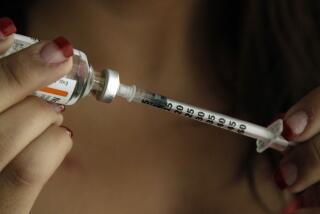Availability of sugar influences rate of diabetes, study says
- Share via
In a finding certain to put new pressure on the purveyors of sugary foods and drinks, a worldwide analysis shows that regardless of its effect on obesity, the ebb and flow of sugar in a country’s diet strongly influences the diabetes rate there.
The new study provides compelling evidence that obesity isn’t driving the worldwide pandemic of Type 2 diabetes as much as the rising consumption of sugar — largely in the form of sweetened sodas, experts said.
Increases in sugar intake account for a third of new cases of diabetes in the United States and a quarter of cases worldwide, according to calculations published Wednesday in the journal PLOS ONE. In the 175 countries studied, a 150-calorie daily increase in the availability of sugar — about the equivalent of a can of Coke or Pepsi — raises the prevalence of Type 2 diabetes by 1.1%, a research team from Stanford University and UC San Francisco found.
Dr. Walter Willett, a nutritionist and epidemiologist at the Harvard School of Public Health, said the results almost certainly underestimated the role of added sugar in the development of diabetes, since the data didn’t distinguish between sugar that comes from fresh fruit and sugar that is concentrated in junk foods and sodas with no other nutrients.
The results make clear that sugar consumption “is fueling the global epidemic of diabetes,” and that reducing that consumption is an essential step in controlling the rise of the disorder, said Willett, who was not involved in the study.
Over the last half-century, the increasing availability of sugar has made 62 new calories available every day to each man, woman and child on Earth. Most of that extra sugar has been produced in the last decade, as the U.S., China and other countries have vastly expanded their production of sweetener for the world market.
The result has been a global rise in the number of people who are overweight or obese, with an estimated 1.4 billion adults over 20 falling into one of those categories, according to the World Health Organization. Type 2 diabetes was once a disease of affluence, but it now affects an estimated 312 million people in rich and poor countries alike; WHO estimates that diabetes deaths — largely due to cardiovascular disease — will increase by two-thirds to about 5.7 million by the year 2030.
Whether sugar consumption or obesity is the biggest factor in diabetes is an unresolved question with important implications for public health policy. If obesity is the primary cause, measures that boost exercise and reduce intake of any kind of calories should drive down diabetes rates. If sugar is responsible, the emphasis should shift to reducing the amount of the sweetener consumed in food and drinks.
Plenty of research implicates sugar-sweetened beverages as playing an outsized role in weight gain. For instance, studies that tracked people for up to 20 years have found that with each daily serving of soda a person consumes, the risk of developing diabetes rises by 15% to 25%, Willett said. A 12-ounce serving of Coca-Cola contains 140 calories, primarily from sugar, and the equivalent serving of Pepsi has 150 calories.
The beverage industry, which generates billions of dollars in worldwide sales of such products, has mounted a spirited defense against measures aimed at reducing soda consumption, including so-called soda taxes and limits on the size of fountain drinks that can be sold in snack bars and concession stands.
Dr. Robert Lustig, an expert on sugar metabolism and senior author of the new study, said that in light of its findings, soda manufacturers can no longer reasonably argue that calories from their products are no more dangerous than calories from any other source.
The study tracked changes in diabetes rates, sugar availability and a host of other social and health factors in 175 countries between 2000 to 2010. The researchers used data on sugar availability instead of sugar consumption because the U.N.’s Food and Agricultural Organization consistently tracks market availability of sugar and several other categories of food. The U.N. does not distinguish among various forms of sugar, including table sugar and high-fructose corn syrup.
The researchers found that in countries where the incidence of diabetes went up, the availability of sugar had increased earlier and in roughly the same proportion. By establishing a dose-response relationship, the study allows researchers to infer that high doses of sugar causes diabetes.
The direct relationship held up even when the researchers considered sugar’s role in weight gain and obesity’s role in diabetes. In countries where average calorie intake was relatively low, obesity was rare and physical activity was common, people were more likely to develop diabetes if availability of sugar was high. The analysis explains why diabetes rates have dropped in countries like New Zealand, Iceland and Pakistan despite surging obesity and why the disease is on the rise in places like the Philippines, Romania, Bangladesh and Sri Lanka even though few people there are obese.
“This is as good as medicine gets in terms of proving causation,” said Lustig, a pediatric endocrinologist at UCSF who has long warned of the health dangers of sugary drinks, including fresh juice. The study should mark “a tipping point” in the public debate over the regulation of sugar-sweetened soft drinks, he added.
The American Beverage Assn. took issue with Lustig’s claims.
“This study does not show — or even attempt to show — that consuming sugar causes diabetes,” the trade group said in a statement. “The study’s conclusions on sugar and diabetes should be viewed cautiously given that the underlying model failed to consider the potential impact of solid fats — such as butter, cheese and lard — or factor for family history.”
In a statement, the Sugar Assn. faulted the study for failing to separate the effects of “natural sugar” and high-fructose corn syrup.






